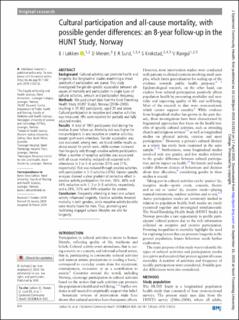| dc.description.abstract | Background Cultural activities can promote health and longevity, but longitudinal studies examining a broad spectrum of participation are scarce. This study investigated the gender-specific association between all-causes of mortality and participation in single types of cultural activities, amount and participation frequency.
Methods We used cohort data from the Nord-Trøndelag Health Study (HUNT Study), Norway (2006–2008), resulting in 35 902 participants, aged 20 and above. Cultural participation in receptive and creative activities was measured. HRs were reported for partially and fully adjusted models.
Results A total of 1905 participants died during the median 8-year follow-up. Mortality risk was higher for non-participants in any receptive or creative activities, except sport event attendees. Gender association was also evaluated: among men, we found similar results as above except for parish work, while women increased their longevity only through creative activity participation. When a number of receptive activities was associated with all-cause mortality, reduced risk occurred with attendance in 2 or 3–4 activities (21% and 31%, respectively). Risk was reduced through creative activities, with participation in 3–5 activities (43%). Gender-specific analyses showed a clear gradient of protective effect in creative activity participation: for men, 28%, 44% and 44% reduction with 1, 2 or 3–5 activities, respectively, and a 28%, 35% and 44% reduction for women.
Conclusion Frequently attending at least one cultural activity influenced longevity. Creative activities lowered mortality in both genders, while receptive activity benefits were mostly found for men. Thus, promoting and facilitating engaged cultural lifestyles are vital for longevity. | en_US |
